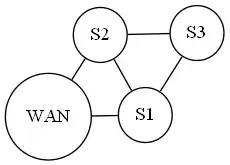An industrial site needs to link 3 seperate areas in a building in such a way that all the switches are on the same network and sharing the same wan link. The wan link will only be coming in from one of the sites and attached to the switch.
ie
SITE 01--SITE 02------WAN LINK | / | / | / SITE 03
The distance between each site will likely be greater than 300 meters.
They intend to connect SITE 01 to SITE 02 with 2 lines of Single Mode fibre. Same method to connect SITE 02 to SITE 03 Ditto for connecting SITE 03 to SITE 01
The fibre will connect to switches at each site via SFP+ transceivers.
The switches will have SPF+ 10Gbe ports.
The so called 2x fibre line to each site using ring topology is apparently for high availability.
Similarly, each site will have 2 switches, stacked.
I worry that the client may not know what he is doing. Please comment.


